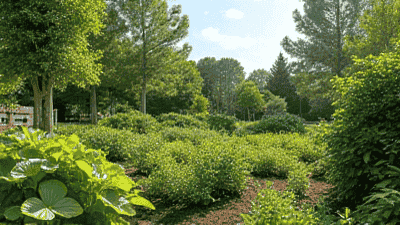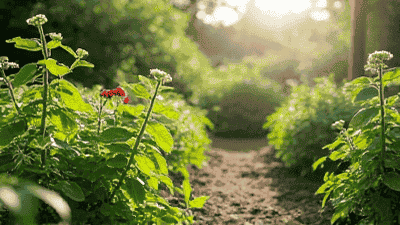
In a world searching for sustainable solutions, gardening practices that minimize soil disturbance and enhance ecological balance have become increasingly popular. The no dig garden method offers an efficient and sustainable approach to growing food, flowers, and other plants while improving soil health and supporting local ecosystems.
The no dig gardening method is based on the principle of minimizing soil disturbance. Traditional gardening practices often involve tilling the soil, which can lead to numerous downsides such as soil erosion, disruption of beneficial organisms, and nutrient depletion. In contrast, no dig gardening focuses on building a thriving ecosystem within the soil and promoting overall soil health.
Soil Biology: Healthy soil is a living ecosystem teeming with organisms, including bacteria, fungi, earthworms, and insects. The no dig method seeks to preserve this biological balance, fostering a thriving garden environment.
Layering: In a no dig garden, organic materials are layered on top of the soil to build soil fertility and structure over time. This practice mimics natural processes and leads to improved nutrient cycling.
Mulching: Applying organic mulch helps maintain moisture, suppress weeds, and provide organic matter as it breaks down, contributing to soil health.
Minimal Disturbance: By avoiding tilling and disturbance, no dig gardening helps preserve soil structure, prevent erosion, and protect beneficial soil organisms.

Adopting a no dig gardening approach offers a multitude of advantages that align with sustainable living principles:
Soil health is fundamental to successful gardening. The no dig method promotes the development of rich, nutrient-dense soil by allowing organic matter to build up gradually while fostering the growth of beneficial soil organisms.
No dig gardening encourages a diverse ecosystem, attracting beneficial insects, pollinators, and other organisms that contribute to the overall health of your garden.
Using mulch as a protective layer on top of the soil minimizes weed growth and competition for resources, making it easier to maintain a thriving garden.
A no dig garden retains moisture more effectively, reducing the need for frequent watering and enhancing drought resilience. Well-structured soil allows for improved water infiltration and retention.
By using organic materials and reducing soil disturbance, the no dig method aligns with sustainable gardening principles, leading to a greener and healthier ecosystem.
No dig gardening requires less labor than traditional tilling methods, making it a suitable option for gardeners of all experience levels and physical abilities.
Choose an appropriate location for your no dig garden, considering factors such as sunlight, drainage, and access to water. Look for a spot that receives at least six hours of sunlight per day and has good drainage to prevent waterlogging.
While the no dig method minimizes disturbance, the site still requires some preparation to create an ideal environment for your garden.
Remove any existing weeds, debris, or grass from the area using hand tools. It is essential to eliminate unwanted plants to minimize competition as you establish your garden.
If you have existing soil, assess its condition by checking its texture, drainage, and nutrient levels. It may be helpful to conduct a soil test to gain insights into your soil's current state.
The success of your no dig garden relies on the quality of the organic materials you choose. Aim to create a layered structure that enhances soil fertility.
Gather a variety of organic materials to create layers, including:
Consider adding organic fertilizers, such as bone meal, blood meal, or fish emulsion, to enhance the nutrient content of your garden.
Building layers is a critical component of establishing a no dig garden. Follow these steps to create effective layers for your garden:
Start by creating a base layer directly on the ground. Use thick cardboard, newspapers, or biodegradable materials to create a barrier that suppresses existing grass and weeds. This layer should be at least four to six sheets thick.
Next, apply a layer of well-rotted compost or other organic matter ranging from four to six inches thick. This layer will enrich the soil and provide a nutrient source for plants.
Finally, cover the organic matter layer with mulch, keeping it approximately two to four inches deep. Mulching protects the soil, conserves moisture, and suppresses weeds.
Once your layers are established, you can begin planting in your no dig garden.
Choose plants based on your climate, preferences, and available space. Opt for companion planting, where compatible plants benefit each other when grown together.
To plant in your no dig garden, simply create a small hole in the mulch and organic matter layers and place your seeds or seedlings into the soil below. Gently cover the plant roots with decomposed materials and replace the mulch around the plant.
Maintaining a no dig garden requires less effort than traditional gardening practices, but it still needs care.
Ensure that your no dig garden receives adequate water, especially during dry periods. Water deeply and infrequently to encourage deep root growth. Utilize rainwater harvesting systems for a sustainable water source.
Periodically replenish the mulch layer as it decomposes. Over time, organic materials break down and contribute to soil health, leading to nutrient-rich compost over time.
Although no dig gardens are known for suppressing weeds, it is essential to remain vigilant. Hand-pull any weeds that appear and cover them with additional mulch as needed.
As plants mature, you will eventually be able to enjoy fresh, homegrown produce from your no dig garden.
Monitor your plants for signs of readiness. Each crop has its harvesting guidelines, so be sure to research the optimal times for harvesting specific plants.
Use appropriate tools to harvest crops, taking care not to damage surrounding plants. Harvest gently and enjoy the fruits of your labor!

Once you’ve established a successful no dig garden, consider enhancements to improve productivity and sustainability.
Practice crop rotation by changing the location of specific plants each growing season. This prevents soil nutrient depletion while reducing the risk of pests and diseases.
Interplanting involves growing different types of plants in close proximity. This practice fosters biodiversity, attracts beneficial insects, and maximizes garden space.
Implement composting practices to generate your own organic matter for future layers. Composting kitchen scraps and garden waste helps build healthy soil and reduce waste.
Include plants that attract pollinators, such as bees and butterflies, to promote a healthy ecosystem. Plant flowering herbs, native flowers, and other pollinator-friendly plants.
Perennials are plants that return year after year without needing to be replanted. Incorporating perennial vegetables, herbs, and flower varieties can promote longevity and stability in your no dig garden.
While no dig gardening offers numerous benefits, challenges may arise along the way. Here are some common challenges gardeners face and potential solutions:
If you notice signs of nutrient deficiencies, supplement with organic fertilizers or additional compost to restore soil health.
If certain weeds persist despite mulching, consider reapplying additional layers of cardboard or newspaper, covering more areas to combat persistent growth.
Utilize companion planting and natural remedies to deter pests. Additionally, encourage beneficial insects, such as ladybugs or lacewings, to help manage pest populations.
If drought conditions threaten your garden, implement water-saving practices such as drip irrigation or rainwater harvesting to ensure plants receive adequate moisture.

Building a no dig garden is an excellent sustainable approach to gardening that promotes soil health, biodiversity, and eco-friendly practices. By minimizing soil disturbance and focusing on organic practices, you can create a thriving garden that supports both your needs and the local ecosystem.
With patience and dedication, a no dig garden can yield a significant bounty while enhancing your connection to nature and fostering a more sustainable lifestyle. As you embark on this gardening journey, remember that every small step contributes to a healthier planet and a fulfilling gardening experience.